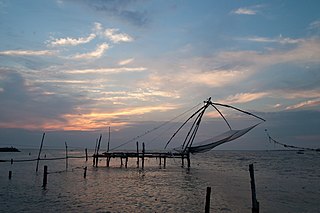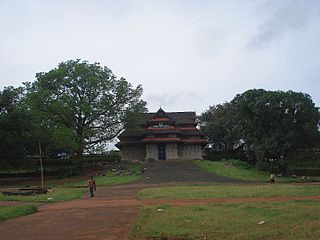
Thrissur, formerly Trichur, also known by its historical name Thrissivaperur, is a city and the headquarters of the Thrissur district in Kerala, India. It is the third largest urban agglomeration in Kerala after Kochi and Kozhikode, and the 21st largest in India. The city is built around a 65-acre (26 ha) hillock called Thekkinkadu Maidanam which seats the Vadakkunnathan temple. It is located 304 kilometres (189 mi) north-west of the state's capital city, Thiruvananthapuram. Thrissur was once the capital of the Kingdom of Cochin, and was a point of contact for the Assyrians, Greeks, Persians, Arabs, Romans, Portuguese, Dutch and English.

The ThrissurPooram is an annual Hindu temple festival held in Thrissur, Kerala, India. It is held at the Vadakkunnathan Temple in Thrissur every year on the Pooram day—the day when the moon rises with the Pooram star in the Malayalam Calendar month of Medam. It is the largest and most famous of all poorams in India. Thrissur pooram is also one of the largest festivals in Asia with more than 1 million visitors.

The Kingdom of Cochin or the Cochin State, named after its capital in the city of Kochi (Cochin), was a kingdom in the central part of present-day Kerala state. It originated in the early part of the 12th century and continued to rule until its accession to the Dominion of India in 1949.
Nedumpuram Palace is situated in Tiruvalla, Pathanamthitta District, Kerala, India. The palace belongs to a branch of the Kulasekhara dynasty that ruled the principality of Udayamangalam in Northern Kerala. The family belongs originally to the Valluvanad royal line of ascension who presided over the Mamamkam festival. During the southern campaign of Tippu Sultan, the family relocated to the south of Kerala and took shelter under the patronage of the King of Travancore. The family divided into two branches establishing principalities within Travancore in Mariapalli and Tiruvalla. Tiruvalla was ruled by Raja Raja Varma for a period of 3 years. His only son Damodaran Thampi left the kingdom to serve at Sree Vallabha Temple and was known as His Holiness Damodaran Thampi. He was fondly called as Damodaran Adhikari. He was known for his charitable contributions. The current palace stands at the location of an earlier palace that belonged to the erstwhile Raja of Tiruvalla.

The Vadakkumnathan Temple is an ancient Hindu temple dedicated to Shiva in Thrissur, in the Thrissur district of Kerala, India. The temple is a classical example of the architectural style of Kerala and has one monumental tower on each of the four sides in addition to a koothambalam. Mural paintings depicting various scenes from the Mahabharata can be seen inside the temple. The shrines and the Kuttambalam display vignettes carved in wood. The temple, along with the mural paintings, has been declared as a National Monument by India under the AMASR Act. According to popular local lore, this is the first temple built by Parashurama, the sixth avatar of Vishnu. Thekkinkadu Maidan, encircling the Vadakkumnathan Temple, is the main venue of the renowned Thrissur Pooram festival.

Rama Varma Kunji Pillai Thampuran (1751–1805), or Rama Varma IX, popularly known as Sakthan Thampuran, was the ruler of the Kingdom of Cochin. The current southern Indian city of Kochi was part of the erstwhile princely state of Kochi. He resided at Vadakkechira Palace in Thrissur. The city of Thrissur is referred to as the Cultural Capital of Kerala owing to its many traditional festivals and historic temples. Sakthan Thampuran is considered the architect of the city of Thrissur. The festival Thrissur Pooram was started by him.

Kochi is an ancient city located in the Ernakulam District in the Indian state of Kerala about 200 km from Thiruvananthapuram, the capital of Kerala.

Rama Varma I often referred to as Dharma Raja, was the Maharajah of Travancore from 1758 until his death in 1798. He succeeded his uncle Marthanda Varma, who is credited with the title of "maker of modern Travancore". During his reign Dharma Raja not only retained all the territories his predecessor had gained but administered the kingdom with success. He was addressed as Dharma Raja on account of his strict adherence to Dharma Sastra, the Hindu principles of justice by providing asylum to thousands of Hindus and Christians fleeing Malabar during the Mysorean conquest of Malabar.

Thrissur is the administrative capital of Thrissur District, in the central part of Kerala state, India. Thrissur district was formed on 1 July 1949. It is an important cultural centre, and is known as the Cultural Capital of Kerala. It is famous for the Thrissur Pooram festival, one of the most colourful and spectacular temple festival of Kerala. From ancient times, Thrissur has been politically, economically and culturally significant to the Indian subcontinent. It has opened the gates for Arabs, Romans, Portuguese, Dutch and English. According to tradition, Thrissur is where Christianity, Islam and Judaism entered the Indian subcontinent. Local Christian tradition holds that Thomas the Apostle arrived in 52 CE, and Muslim tradition states that Methala is the location of country's first mosque.

Puli kali is a recreational folk art from the state of Kerala, India. It is performed by trained artists to entertain people on the occasion of Onam, an annual harvest festival, celebrated mainly in the Indian state of Kerala. On the fourth day of Onam celebrations, performers painted like tigers and leopards in bright yellow, red, and black shake their bellies and dance to the beats of instruments like Chenda and Chengila. The literal meaning of Pulikkali is 'The tiger dance' hence the performance revolves around the theme of tiger hunting. Folk art is mainly practiced in the Thrissur district of Kerala. The best place to watch the show is at Thrissur on the fourth day of Onam, where Pulikkali troupes from all over the district assemble to display their skills. The festival attracts thousands of people to the Thrissur city. Pulikkali is also performed during various other festive seasons.

Hill Palace is an archaeological museum and palace located in the Tripunithura neighbourhood of Kochi, Kerala. It is the largest archeological museum in the state and was the imperial administrative office and official residence of the Cochin Maharaja. Built in 1865, the palace complex consists of 49 buildings spreading across 54 acres (220,000 m2) and built in the traditional architectural style. The complex has an archaeological museum, a heritage museum, a deer park, a pre-historic park and a children's park.
The name Rama Varma refers to a number of persons from many royal families of Kerala in southern India.

Sir Sri Rama Varma XV (1852–1932), known as the Rajarshi of Cochin and as Ozhinja Valiya Thampuran, was the ruler of the Kingdom of Cochin from 1895 to 1914.

Vadakkechira is one of the four oldest ponds in Thrissur city of Kerala in India. It was built by Shakthan Thampuran (1751-1805) and is one of Thrissur's famous landmarks. It is owned by Cochin Devaswom Board.

Kerala Varma Thampuran popularly known as Aikya Keralam Thampuran or Kerala Varma VII was the Maharaja (king) of Cochin who ruled between 1946 and 1949. He mooted the idea of a unified Kerala state in India for the Malayalam speaking population and stood for the merging of British Malabar, Cochin and Travancore. Therefore, he was given the sobriquet Ikyakeralam Thampuran. He died in July 1948. He was also the brain behind the formation of Sree Kerala Varma College at Thrissur, named after him.

Thekkinkadu Maidanam is a historic open ground located in the center of Thrissur city in the Kerala state of India. The 65-acre area surrounds the ancient Vadakkunnathan Temple, one of the most significant Shiva temples in Kerala, and is a vital cultural and historical landmark. The maidan is under the management of the Cochin Devaswom Board and plays host to a variety of public events, including the famous Thrissur Pooram, one of the largest temple festivals in Kerala, often referred to as the "Mother of all Poorams."

Central Prison & Correctional Home, Viyyur, is situated in Thrissur in Kerala state of India and is authorised to accommodate 520 prisoners. It is one of the four central prisons other than Poojappura, Kannur and Tavanur, situated in Kerala state. It is one of the most important correctional and detention centers in the state. As per Kerala Prison Rules, the prison is meant to detain convicted habitual prisoners on a long-term basis. The prison has separate buildings designated as special jail and sub-jail meant for short-term convicts and people on trial, respectively.
Aripalam is a village situated in Thrissur district, Kerala, India. Nearest towns are Irinjalakuda and Kodungallore. Main highlight of the village is it is a place between two main roads they are Thrissur - Kodungallur SH22 and Panvel - Edappally Road to connecting NH17 - NH47.

Cochin Tirumala Devaswom, also called Gosripuram is the biggest and most important socio-religious institution of Gowda Saraswat Brahmins of Kerala, India. The temple is situated at Cherlai in the heart of Mattancherry town in Cochin area which is one of the earliest settlements of GSBs in Kerala. The temple was established in the later half of the 16th century. The history of GSBs in Kerala is inter-woven with that of this temple and its Venkateswara idol.




















